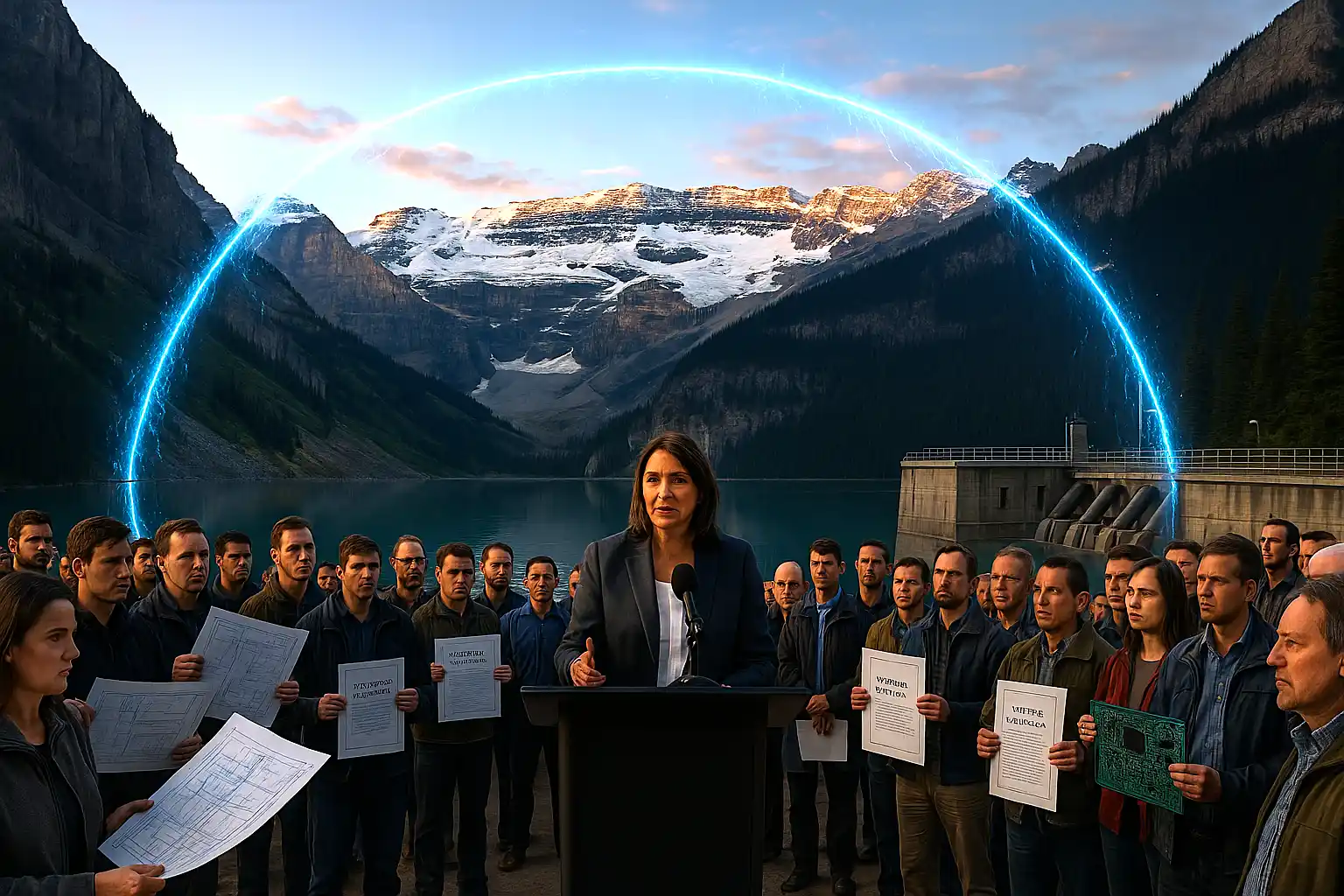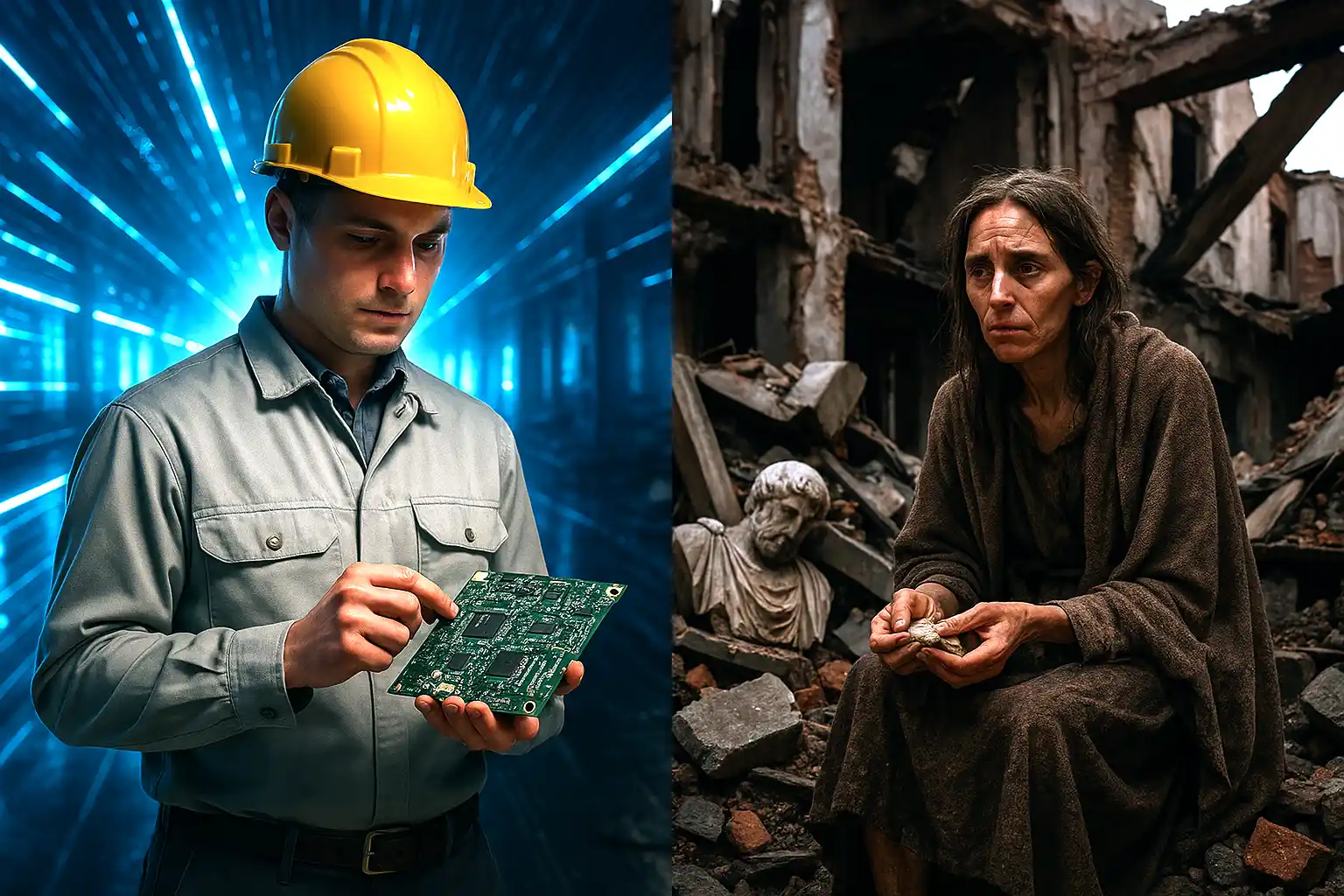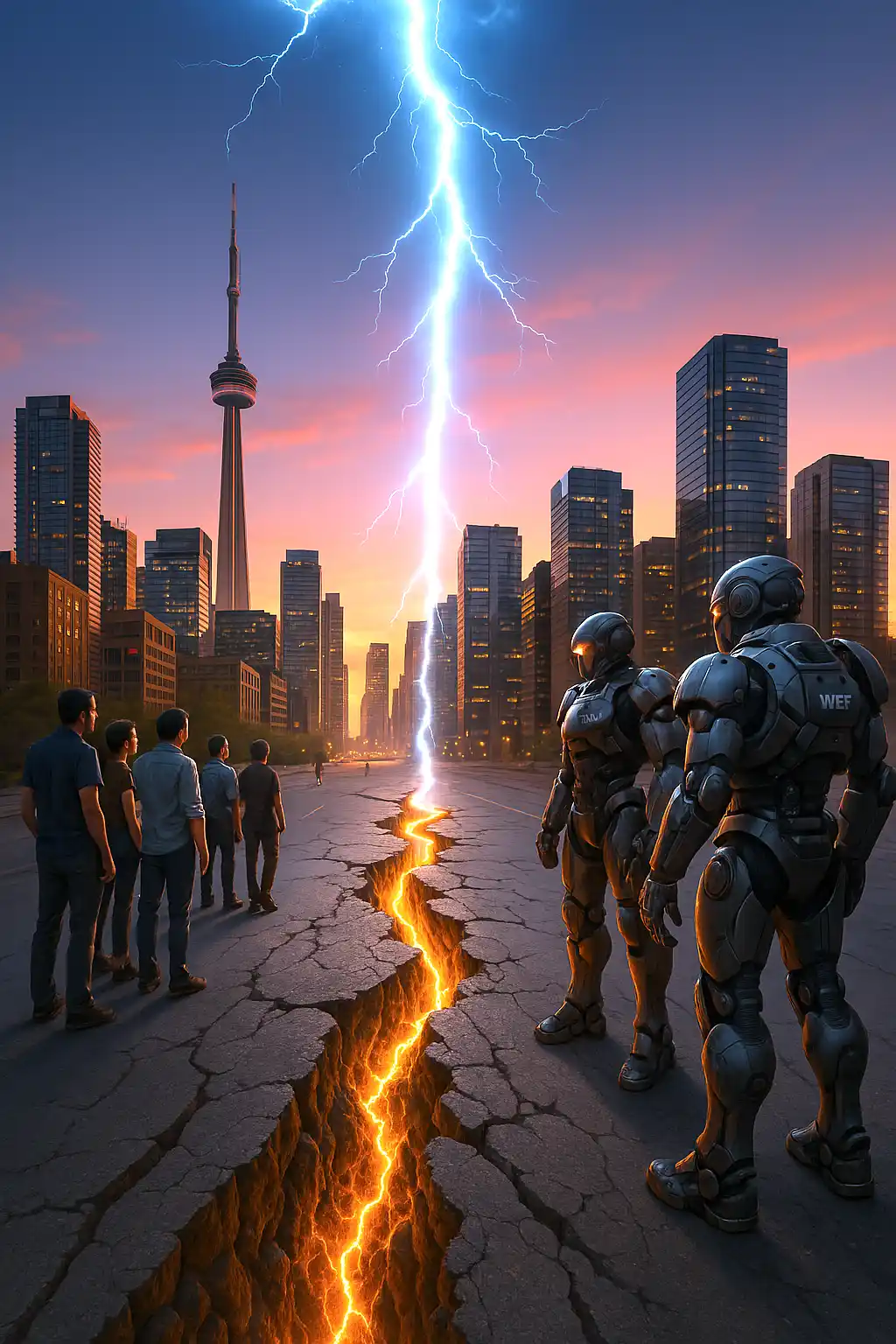Abstract
Since the 1970s, Canada has faced a profound identity crisis rooted in a pivotal philosophical schism within Western thought. On one side stand the Builder’s philosophies, steeped in rationalism, empirical science, and national sovereignty — approaches that propelled Canada’s industrial and technological growth. On the other, Deconstructionist schools prioritize social critique, identity-driven relativism, and the dismantling of established norms. This essay examines how these contrasting intellectual currents shape Canada’s transition from a sovereign, industrious nation to what some call a “post-national” or “borderless” experiment. By analyzing historical philosophical movements, legal underpinnings of bodily autonomy, and current political leadership — exemplified by figures like Pierre Poilievre, Danielle Smith, and Mark Carney — this paper outlines the stakes involved in Canada’s choice between rebuilding or deconstructing its identity and it’s society.
1. The 1970s Intellectual Schism: When Philosophy Abandoned Builders and Embraced Deconstruction
Recent decades have seen many Canadians express a deep sense of unrest — a feeling that core national values, public safety, and civic structures are eroding. Streets feel less secure, schools seem detached from foundational teachings, and government policies appear more centralized and surveillance-oriented. Far from being an overnight change, this climate reflects a deeper philosophical rift dating to the 1970s, when Western thought bifurcated into two opposing camps:
-
The Builder’s Philosophy — rooted in engineering-friendly logic, empirical research, national sovereignty, and structured innovation.
-
The Deconstructor’s Philosophy — guided by postmodern and post-structural critiques, focusing on social deconstruction, power relations, and identity-driven relativism.
This essay contends that the ongoing tension between these two philosophies explains Canada’s current struggles: a declining sense of sovereignty, a shift in social values, and an expansion of globalist and AI-driven power structures.
2. The 1970s Intellectual Schism
2.1 Philosophies Aligned with Engineering, Science, and Progress
For much of the 18th to mid-20th centuries, Western philosophy and Canadian nation-building evolved in tandem, emphasizing rational construction and empirical problem-solving. Key streams include:
-
Rationalism & Empiricism: René Descartes, Baruch Spinoza, Gottfried Wilhelm Leibniz (Rationalists) grounded knowledge in logic and mathematics. [1] John Locke, George Berkeley, David Hume (Empiricists) insisted on observation and scientific experimentation. [2]
-
German Idealism: (Immanuel Kant, G.W.F. Hegel) Influenced early computing theories by reconciling rational and empirical insights, impacting later developments in AI and systematic reasoning. [3]
-
Pragmatism & Utilitarianism Charles Sanders Peirce, William James, John Dewey (Pragmatism) stressed practical, science-based problem-solving — reflecting the mindset of engineers. Jeremy Bentham, John Stuart Mill (Utilitarianism) applied cost-benefit analysis to policy, affecting public works and social programs in early industrial Canada. [4]
-
Cybernetics & Systems Thinking Norbert Wiener, Claude Shannon, John von Neumann, Alan Turing laid the foundations of modern computing and AI by exploring information theory, control systems, and logical structure. [5]
-
Analytic Philosophy Bertrand Russell, Ludwig Wittgenstein, Gottlob Frege emphasized logic and linguistic clarity, cornerstones for software development, mathematics, and the engineering mindset. [6]
These traditions collectively formed a “Builder’s Philosophy”: they regarded empiricism, rational design, and structured knowledge as essential for constructing robust societies. In Canada, these modes of thought propelled railroads, energy sectors, resource-based industries, and a strong sense of national security.
2.2 The “Out Of View” Engineering Philosophy
Crucially, engineering-oriented philosophy did not vanish in the 1970s. Even as postmodern and deconstructionist ideas rose in humanities and social sciences, the engineering world continued to rely on mathematics, empirical data, and systemic design principles. For instance:
-
Systems Engineering & Control Theory in the 1970s onward expanded on earlier cybernetic ideas, focusing on feedback loops and robust technological solutions.
-
Software & AI Logic advanced through algorithms, computational linguistics, and structured programming (e.g., Dijkstra, Hoare) outside the main currents of postmodern academia.
-
Industrial Design & Practical Ethics (e.g., engineering codes of conduct) remained rooted in functionality, safety, and pragmatic problem-solving, rarely engaging with the identity-driven relativism found in the humanities.
This parallel track explains why many engineers and technologists, while vaguely aware of postmodern or deconstructionist trends, found them incompatible with the day-to-day demands of building systems. In effect, “Builder’s Philosophy” continued, albeit in specialized domains (STEM fields, R&D labs, corporate engineering teams), largely isolated from the broader social critiques permeating universities, work envioronments, policy makers and media,
2.3 Philosophies That Diverged into Social & Experimental Domains
While earlier philosophies sought to build systems, the late 20th century saw the rise of schools that deconstructed them. Around the 1970s, postmodernism, post-structuralism, and identity-based critical theories gained traction in universities, media, and public policy:
-
Postmodernism (Michel Foucault, Jacques Derrida, Jean-François Lyotard) Rejected universal truths, emphasizing power structures and linguistic relativity. [7]
-
Post-Structuralism (Judith Butler, Roland Barthes, Gilles Deleuze) Focused on how language and social constructs shape identity; heavily influenced gender theory and subjective lived experience. [8]
-
Critical Theory & The Frankfurt School (Theodor Adorno, Max Horkheimer, Jürgen Habermas) Reinterpreted Marxism to prioritize culture and identity over purely economic analyses, framing many Western norms as tools of oppression. [9]
-
Transhumanism & Corporate AI Ethics (modern iteration) Extends postmodern skepticism to human nature itself, proposing that merging people with technology is either inevitable or desirable — often sidestepping autonomy concerns in favour of global or corporate oversight. [10]
By the 1970s, these movements increasingly supplanted empirical, builder-friendly philosophies in academic and state-funded spheres, challenging classical notions of nationhood, rational debate, and structured progress.
3. Escaping Communism to End Up in “Covert Deconstruction Communism”
3.1 From Sovereign Nation to Global Experiment
Canada’s pivot toward deconstructionist outlooks is nowhere more evident than in its drift from a sovereign industrial power to a borderless policy experiment:
-
Laurentian Elite Influence: Central Canadian power brokers (Toronto, Ottawa, Montreal) tightened alliances with international banking (e.g., the WEF) and global climate policy networks. [11]
-
Redefining Citizenship: Once tied to earned responsibilities, citizenship has become fluid and “post-national,” diminishing Canada’s historical ethos of hard work, self-reliance, and innovative enterprise. [12]
-
Weaponized Diversity: While multiculturalism was once unifying, it has morphed into identity-driven fragmentation, overshadowing common purpose or merit-based advancement. [13]
-
Economic & Regulatory Capture: Bureaucratic overreach (e.g., carbon taxes) stifles local industry while empowering foreign investors and international finance. [14]
Canada thus transitions away from a sovereign nation to what some critics describe as a “hyper-regulated playground” for global or corporate interests — mirroring the concerns of many who fled past authoritarian regimes only to sense a covert form of the same top-down controls re-emerging under the guise of progress.
3.2 Bio-Security Rights & Bodily Autonomy: The Next Battleground
Under Canadian law, “security of the person” is guaranteed by both the 1960 Canadian Bill of Rights and Section 7 of the Canadian Charter of Rights and Freedoms. [15]
Courts have often upheld bodily autonomy (e.g., the right to refuse medical treatment). However, globalist-leaning figures — such as Mark Carney with ties to the WEF — propose frameworks that risk eroding these protections for profit or centralized control.
-
Corporate AI & Medical Intrusion: The push for bio-metric data collection and possible “upgrades” to human biology runs counter to the individual’s right to full autonomy over their body and genetics.
-
Borderless Medicine: Decisions about bodily autonomy could shift away from local or individual authority and toward international or corporate boards. [16]
4. Builders’ Defense: Danielle Smith & Pierre Poilievre
Two prominent Canadian leaders — Danielle Smith (Alberta Premier) and Pierre Poilievre (Conservative Party of Canada Leader) — have emerged as defenders of builder-style thinking:
-
Danielle Smith Proposed amendments to the Alberta Bill of Rights emphasizing personal medical autonomy, reflecting a provincial-level firewall against federal encroachment or corporate health mandates. [17]
-
Pierre Poilievre Stresses the importance of the Canadian Bill of Rights & Freedoms in safeguarding bodily and economic autonomy. Prioritizes AI safety and national sovereignty to ensure advanced technology does not override human rights or local governance. [18]
4.1 Why Two-Tiered Protection Matters
-
Provincial Shield: Local legislation (e.g., Alberta’s Bill of Rights) offers more immediate defense of medical and property freedoms.
-
Federal Framework: National-level protections (Charter, Bill of Rights) set a broad legal standard that can resist pressures from global corporate or finance alliances.
Together, these layers give Canadians a two-tiered security system against potential overreach by multinational banks, AI-driven firms, or globalist policy agendas and foreign military powers/foreign influence.
5. Poilievre vs. Carney: Two Divergent Worldviews
5.1 Pierre Poilievre: The Builder’s Ethos
-
National Sovereignty & Bodily Autonomy: Advocates for strong borders, local industries, and the right of Canadians to self-govern.
-
AI Safety & Economic Prudence: Cautions against foreign political, foreign military or corporate interests controlling Canada’s digital infrastructure, ensuring positive human-centric tech policies.
5.2 Mark Carney: Globalist-Banking Alignment
-
Climate Finance & WEF Ties: Proposes large-scale economic re-engineering under transnational banking and climate mandates, which may impose top-down constraints on local autonomy.
-
Potential Erosion of Autonomy: Such frameworks often centralize decision-making power, relegating individual rights and national sovereignty to second-tier concerns — especially under a post-national or borderless worldview. (Inherited also from Liberal Party philosophy of all MPs and members).
6. Consequences for the Average Canadian
-
Government-Imposed Identity Shifts: Public education and media sometimes rewrite Canada’s historical narrative, diluting the emphasis on traditional community values.
-
Bodily Autonomy Challenges: From vaccine mandates to potential biometric monitoring, Canadians may find “security of the person” contested by new global or corporate imperatives.
-
Economic Displacement: Policies like the carbon tax or other global climate measures can hobble local industries while benefiting outside investors — raising issues of economic sovereignty.
-
Social Fragmentation: Mass-scale demographic changes without cohesive integration strategies can foster tension rather than unity, especially as identity politics overshadow shared goals.
-
Corporate and AI Dominance: In a digital era, large tech and finance consortia could overshadow elected governance, intensifying debates on AI ethics, data rights, and public accountability.
7. Conclusion: Rebuild or Deconstruct?
Canada stands at a critical juncture. On one path, the Builder’s Philosophy reclaims a legacy of engineering-minded progress, national sovereignty, and individual autonomy. On the other, the Deconstructor’s Philosophy drives an intensifying erosion of borders, traditional identity, and bodily freedoms under the banner of post-national or “progressive” ideals.
-
Rebuild: Uphold a rational, structured approach, drawing on Canada’s heritage of pragmatism, technological innovation, and defense of human rights.
-
Deconstruct: Continue down a route that emphasizes subjective identities, global corporate alliances, and AI-driven reorganizing of society — potentially alienating citizens from both their history and their personal sovereignty.
As @CCFR_CCDAF19 and @SkillsGapTrain
[20] have documented in their analyses, the outcome of this philosophical tug-of-war will decide if Canada remains a sovereign and innovative power or is subsumed into a borderless, corporatized experiment.
Figures like Danielle Smith and Pierre Poilievre champion a return to builder values, whereas leaders such as Mark Carney illustrate how deconstructionist influences persist.
Ultimately, Canadians must choose whether they align with the logical construction that once built the nation or the unfettered deconstruction that aims to transform it beyond recognition.
Semi-Final Note
In merging engineering-oriented pragmatism with empirical depth, Canada once thrived as a sovereign builder. The spread of postmodern and deconstructionist philosophies since the 1970s, however, has introduced new paradigms that challenge established norms — from bio-security rights to the notion of a nation-state itself. Whether Canada rebuilds around the logical, structured ethos of its founding centuries or succumbs to unrestricted deconstruction remains one of the defining questions of the nation’s 21st-century trajectory.
Final Note for Future
Transhumanism occupies a complex position in the Builder vs. Deconstructor framework. It straddles both camps but is often co-opted by postmodern deconstructionists in its current form.
-
Builder’s Transhumanism: When viewed through the lens of engineering, trans-humanism aligns with Builder philosophies. Early thinkers like Norbert Wiener (cybernetics) and John von Neumann (computing) saw augmentation as a rational, structured means to improve human capabilities — aligned with progress, efficiency, and empirical problem-solving. Military and medical applications (e.g., prosthetics, brain-machine interfaces, AI-assisted cognition) follow the Builder’s ethos of structured technological evolution. Elon Musk’s Neuralink represents this model: enhancing human cognition while preserving autonomy.
-
Deconstructor’s Transhumanism: In its modern ideological form, transhumanism is often influenced by postmodern and deconstructionist thought. It rejects essential human nature, embracing fluid identities where the body itself is seen as a social construct subject to modification. The focus shifts from structured augmentation to corporate or globalist control over bodies — linking to Mark Carney’s economic frameworks and WEF-style governance. AI-driven decision-making could replace empirical knowledge and national sovereignty, embedding humans within centralized technological ecosystems rather than enhancing their autonomy. The extreme end proposes post-biological existence, where human identity itself dissolves into digital consciousness — a deeply postmodern, deconstructive notion.
Conclusion: Transhumanism as a Battleground
Transhumanism is neither purely Builder nor fully Deconstructor; it is a tool that can be wielded by either philosophy. The critical issue is who controls its implementation:
-
Builder-aligned transhumanism (e.g., engineering-driven progress, human sovereignty in augmentation).
-
Deconstructionist transhumanism (e.g., corporate or globalist restructuring of human identity, eroding bodily autonomy).
Canada’s trajectory in transhumanism will depend on whether figures like Pierre Poilievre and Danielle Smith secure policies ensuring augmentation remains voluntary, decentralized, and human-centered, rather than a post-national, corporate-driven experiment.



To see our Donate Page, click https://skillsgaptrainer.com/donate
To see our YouTube Channel, click https://www.youtube.com/@skillsgaptrainer